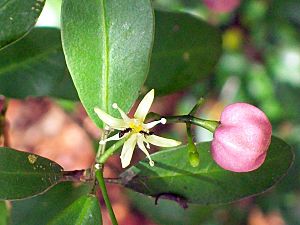Hard aspen facts for kids
Quick facts for kids Hard aspen |
|
|---|---|
 |
|
| Leaves, flower and fruit of Acronychia laevis | |
| Scientific classification | |
| Genus: |
Acronychia
|
| Species: |
laevis
|
| Synonyms | |
|
|
The Hard Aspen (scientific name: Acronychia laevis) is a type of shrub or small tree. People also call it the Glossy Acronychia or Northern White Lilly Pilly. It belongs to the citrus family, just like oranges and lemons! This plant grows naturally only in eastern Australia. It has shiny, egg-shaped leaves, pretty creamy-white flowers, and round, fleshy fruits.
Contents
What Does the Hard Aspen Look Like?
The Hard Aspen is a shrub or small tree. It can grow up to 12 m (39 ft) tall. Its trunk has smooth, light brown bark. You might see some vertical lines and wrinkles on it.
Leaves and Stems
The leaves grow in pairs, one across from the other. They are simple, meaning each leaf is just one blade. They are shaped like an ellipse or an egg, with the narrower part at the bottom. Each leaf is about 25–100 mm (0.98–3.94 in) long and 10–50 mm (0.39–1.97 in) wide. They attach to the stem with a small stalk called a petiole, which is 3–30 mm (0.12–1.18 in) long.
The leaves are shiny green on both sides. Their tips are usually blunt or rounded. If you look closely with a magnifying glass and bright light, you can see tiny oil dots on them.
Flowers and Fruit
The flowers of the Hard Aspen are mostly found where the leaves meet the stem. These groups of flowers are called cymes and are 15–70 mm (0.59–2.76 in) long. Each flower sits on a small stalk called a pedicel, about 3.5–13 mm (0.14–0.51 in) long.
Each flower has four small green parts called sepals, which are 0.5–1.5 mm (0.020–0.059 in) wide. It also has four creamy-white petals, about 5–9 mm (0.20–0.35 in) long. Inside, there are eight stamens (the parts that make pollen) that are different lengths.
Hard Aspen flowers bloom from February to June. After flowering, the plant produces fruit. The fruit is fleshy and can be shaped like a bishop's hat or be more round. It's dark pink and about 7–10 mm (0.28–0.39 in) long. Inside, you'll find reddish-brown seeds, about 4 mm (0.16 in) long. This type of fruit is called a drupe, which means it has a hard pit inside, like a peach.
How the Hard Aspen Got Its Name
The Hard Aspen was first described in 1775. Two German naturalists, Johann Reinhold Forster and Georg Forster, wrote about it. They published their description in a book called Characteres Generum Plantarum.
The scientific name laevis comes from a Latin word meaning "smooth." This name refers to the smooth new shoots and leaves of the plant.
Where the Hard Aspen Grows
The Hard Aspen grows in two main types of forests: dry rainforests and subtropical rainforests. You can find it from sea level up to 1,100 m (3,600 ft) high.
It grows in eastern Australia, from the upper Clarence River in New South Wales all the way up to Cape York Peninsula in Queensland. You can also find this plant on New Caledonia and Lord Howe Island.
Animals That Eat Hard Aspen Fruit
The fruit of the Hard Aspen is a food source for some animals. For example, the green catbird enjoys eating its fruit.
Growing Hard Aspen in Your Garden
You can grow Acronychia laevis in your garden. It does well in sunny spots or places with some shade. Its pretty flowers and interesting fruit make it a nice plant for gardens.
You can start new Hard Aspen plants from seeds. You can also try growing them from cuttings, which means taking a piece of the plant and helping it grow roots.
The fruit of the Hard Aspen is safe for humans to eat. However, most people find it too strong-tasting. Some even say it tastes like turpentine!

